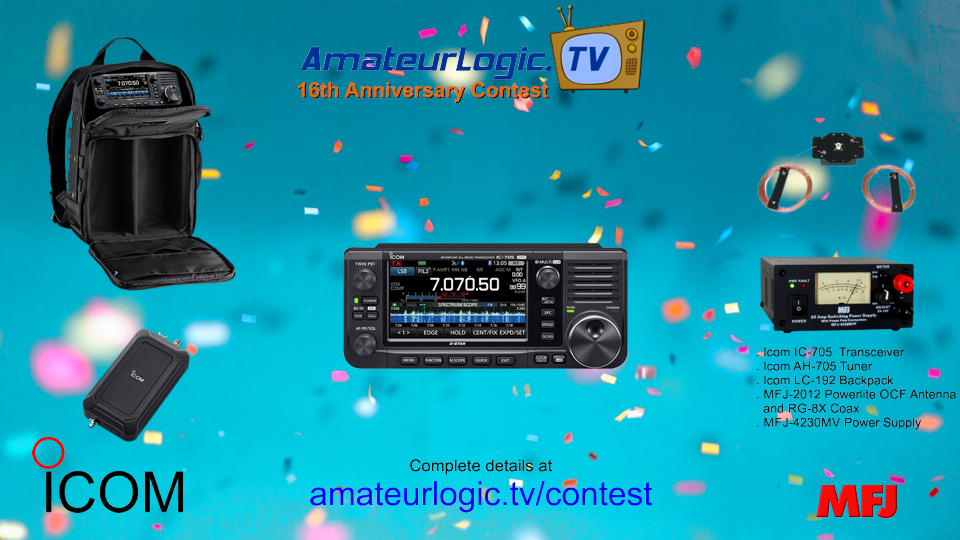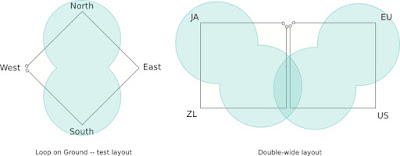 Using 1.2 GHz in the Colorado 14er Event
Using 1.2 GHz in the Colorado 14er Event
Last weekend we held the Colorado 14er Event (Aug 7 and 8), the annual mountaintop event in Colorado. A group of us used this weekend as an opportunity to make 1.2 GHz (23 cm) Summits On The Air (SOTA) contacts: K0NR, K0JJW, KM4PEH, K5RHD, W0ADV, KL7IZW, W0RW, KC5RW, and K0BEJ.

Many of the 1.2 GHz operators used the Alinco DJ-G7T triband handheld transceiver. This radio covers the 2m, 70cm and 23cm bands. The RF output on 23 cm is only 1 watt but it is the lowest-cost way of getting a signal on that band.
Pikes to Uncompahgre
On Saturday, Joyce/K0JJW and I were on Pikes Peak (W0C/FR-004) and worked Randy/K5RHD on Mount Evans (W0C/FR-003) at a distance of 97 km (60 miles). Signals were strong and we had no problem making those contacts.
We also worked David/W0ADV on Uncompahgre Peak (W0C/RG-001) at a distance of 227 km (141 miles). David used the Alinco HT driving a 16-element Comet Yagi. We had a bit more power (10 watts) from our Kenwood TM-541A transceiver, also driving a Comet Yagi antenna. Signals were strong in both directions and these QSOs were a new personal best for both Joyce and me on 1.2 GHz.
Evans to Sunshine
On Sunday, we moved to Mount Evans and Randy/K5RHD activated Pikes Peak. We worked Randy on that peak, the reverse of the QSO on the previous day. Meanwhile, David/W0ADV was climbing two 14ers in the San Juan Mountains: Redcloud Peak (W0C/RG-002) and Sunshine Peak (W0C/RG-004). These two summits are close to each other, separated by a saddle, so it is common to climb them as a pair.

David’s route had him climbing Redcloud first and then continuing on to Sunshine, then returning to Redcloud on the way back down. We worked him on Sunshine and on the return trip over Redcloud, as he headed back to the trailhead.

We had trouble hearing David on Sunshine Peak but his signal was just strong enough that we could complete the contact. His signal was stronger from Redcloud, a surprise because the two summits are close in elevation. I expected them to be about the same in terms of signal path and strength. David reported that there was a ridge to the northeast of Sunshine that might be blocking the signal, but it was not in the way for Redcloud.
So these contacts with Sunshine Peak set a new personal best for both Joyce and me on 1.2 GHz (244 km, 152.6 miles). David clearly did the hard work, summiting two 14ers in a day. (We were on a drive-up mountain with a short hike.) Thanks, David/W0ADV!
I was very pleased with the results from the 14er weekend. Now I am wondering what’s next for us concerning 1.2 GHz. We can probably make radio contacts further out but it is going to depend on the topography of the path. We will have to do some investigation on additional summits to try.
73 Bob K0NR
The post Using 1.2 GHz in the Colorado 14er Event appeared first on The KØNR Radio Site.
Bob Witte, KØNR, is a regular contributor to AmateurRadio.com and writes from Colorado, USA. Contact him at [email protected].
 AmateurLogic 16th Anniversary Contest
AmateurLogic 16th Anniversary Contest

AmateurLogic.TV is celebrating our 16th Anniversary and you could win a complete Icom IC-705 prize package along with accessories from MFJ.
Get all the detail at www.amateurlogic.tv/contest
George Thomas, W5JDX, is co-host of AmateurLogic.TV, an original amateur radio video program hosted by George Thomas (W5JDX), Tommy Martin (N5ZNO), Peter Berrett (VK3PB), and Emile Diodene (KE5QKR). Contact him at [email protected].
 ICQ Podcast Episode 357 – Questions, Answers and Tips
ICQ Podcast Episode 357 – Questions, Answers and Tips
In this episode, Colin Butler (M6BOY) is joined by Leslie Butterfield G0CIB, Edmund Spicer M0MNG and Martin Butler (M1MRB) to discuss the latest Amateur / Ham Radio news. Colin (M6BOY) rounds up the news in brief and in the episode, we feature Questions, Answers and Tips.
ICQ AMATEUR/HAM RADIO PODCAST DONORS
We would like to thank David Reid (W6KL), David Strachan (2M0WHX), and our monthly and annual subscription donors for keeping the podcast advert free. To donate, please visit - http://www.icqpodcast.com/donate
- Ofcom Inquiry About PMR 446 Prosecutions
- Hyderabad Hams Develop Low Cost Transverter for QO-100 Satellite
- ARRL Make Online RF Exposure Calculator Available
- Revised Prediction for Solarcycle 25
- Radio Frequency Interference from Water
- UK Broadband Rollout Trial to Target Hard-to-Reach Homes Through Water Pipes
- Steel Schooner Gedania SP2J/mm Operation
- RSGB 2021 Online Convention
- EI2WRC to Activate Hook Lighthouse for ILLW
Colin Butler, M6BOY, is the host of the ICQ Podcast, a weekly radio show about Amateur Radio. Contact him at [email protected].
 AmateurLogic 159: 3D Fumes, SDR Console, AH-705 Setup
AmateurLogic 159: 3D Fumes, SDR Console, AH-705 Setup
AmateurLogic.TV Episode 159 is now available for download.
Mike 3D prints a custom Solder Fumes Extractor. Emile reviews SDR Console software. Tommy sets up his Icom AH-705 auto tuner. George does some AA exploring.
Announcement of AmateurLogic’s 16th Anniversary Contest. Someone is going to win a great Icom IC-705 transceiver package. Details at amateurlogic.tv/contest .
1:18:50
George Thomas, W5JDX, is co-host of AmateurLogic.TV, an original amateur radio video program hosted by George Thomas (W5JDX), Tommy Martin (N5ZNO), Peter Berrett (VK3PB), and Emile Diodene (KE5QKR). Contact him at [email protected].
 LHS Episode #424: The Weekender LXXVI
LHS Episode #424: The Weekender LXXVI
It's time once again for The Weekender. This is our bi-weekly departure into the world of amateur radio contests, open source conventions, special events, listener challenges, hedonism and just plain fun. Thanks for listening and, if you happen to get a chance, feel free to call us or e-mail and send us some feedback. Tell us how we're doing. We'd love to hear from you.
73 de The LHS Crew
Russ Woodman, K5TUX, co-hosts the Linux in the Ham Shack podcast which is available for download in both MP3 and OGG audio format. Contact him at [email protected].
 Loop On Ground (LOG) Tests At VA7ST
Loop On Ground (LOG) Tests At VA7ST
 |
| Single LOG / Dual LOG - courtesy: va7st.ca |
As man-made noise levels become ever more problematic for radio amateurs, particularly those that are serious about weak-signal DX on the lower bands (160 / 80m), the ‘Loop On Ground’ or ‘LOG’ is proving to be a worthwhile improvement for some.
Bud, VA7ST, near Kelowna, has done some recent experimenting with a LOG as an alternative to listening with his 160 / 80m transmitting antennas and has written a great blog on his findings.
Bud has included some ‘A-B’ tests comparing the LOG to his normally-used vertical or inverted-L and the results are quite interesting.
If you’ve ever considered building a separate quieter low-band antenna, you can find everything you might need to get motivated as well as a nice listing of LOG-related links in Bud’s very helpful blog:
https://va7st.ca/2021/02/matching-transformer-for-loop-on-ground-and-beverage-antennas/
and
https://va7st.ca/2021/01/hearing-through-the-noise-on-the-low-bands/
Steve McDonald, VE7SL, is a regular contributor to AmateurRadio.com and writes from British Columbia, Canada. Contact him at [email protected].
 This jig is up. In fact, it’s about to be put to the test…
This jig is up. In fact, it’s about to be put to the test…
We hams often resort to the common claim to choke the “life” out of RFI on feed-lines or other wire carrying electrical current in our shack environment (and nearby) by using ferrite materials in various forms. So it’s just a reflex action to buy those ferrites to install or to make chokes. Wind-em tight. A lot. Pour on the ferrite beads. If one is good, five should be better, especially if they’re cheap. And we like cheap. Right?
Hardly! That jig can be terribly misleading, expensive or, heaven-forbid, make noise worse! That’s a jig that needs to be up.
We do it without knowing because of the genuflection to the folklore of the hobby. Without putting a meter to it to more fully understand just what the ferrite(s) we install are doing. And what we want them to do. But that is the dominant behavioral pattern of many ham operators. Add K4FMH to the list of guilty parties.
It is much easier with that handy-dandy NanoVNA that you got for not much money. IF you know how. Yes, you could read Dunsmore, Witte or Bonaguide & Jarvis. And you should. Or, have someone give you a more practical tutorial. That may well lead you to study the Masters of the VNA as shown below. As Lord Kelvin once said something like: it ain’t science if you ain’t measuring it. Sort of.
Definition of the jig is up: —used to say that a dishonest plan or activity has been discovered and will not be allowed to continue.
Merriam-Webster
It was an honor to get to do a sneak-peek at one of this weekend’s QSO Today Virtual Ham Expo talks on this very subject. Mark Smith N6MTS is giving a talk entitled, Measuring Common Mode Chokes Using a NanoVNA, at 8:00 AM – 9:00 AM: 1500 UTC, 15.08.2021. This talk is worth the price of admission alone if you work HF!
I found it highly engaging, practical, informative, and he’s got the plans to build a test jig (get my title now?) to measure your own chokes before just “hoping” they will do the trick. Mark plans to post those on the Ham Radio Workbench podcast website soon. There are a lot of what look to be great talks scheduled for this weekend. But I know this is one of them because I got the chance to see it already and to share comments with N6MTS.
After you watch Mark’s talk, take a look at one or more of the online NanoVNA groups I am a member of which are listed below. Very helpful and (most always) nice members. Then take a look at Bob Witte’s book if you’re not familiar with it. It’s the preferred gateway drug to the ones by Bonaguide & Jarvis then Dunsmore. Measurement is addictive. And there’s no Twelve Instrument path for withdrawal.
Cited Books:
The VNA Applications Handbook by Gregory Bonaguide and Neil Jarvis.
Handbook of Microwave Component Measurements: with Advanced VNA Techniques 2nd Edition by Joel P. Dunsmore.
Spectrum and Network Measurements, 2nd Edition by Robert Witte.
Online groups on NanoVNAs:
https://groups.io/g/nanovna-users
https://groups.io/g/nanovna-f-v2
Frank Howell, K4FMH, is a regular contributor to AmateurRadio.com and writes from Mississippi, USA. Contact him at [email protected].














